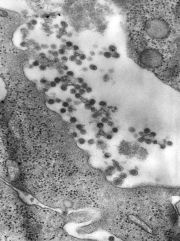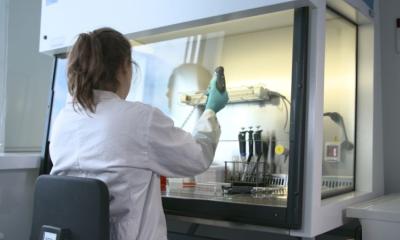How measles virus spread in its host
Every kindergarten undergoes it several times a year: the German measles. Nobody knew exactly how measles enter the body. But it has been thought they come through the surface of airways and lungs. But that is wrong, as researchers from the Mayo Clinic in Minnesota found recently.

Measles virus virions, as they bud from the host cell surface to be freed into the hosts system.
Measles are one of the most common contagious diseases. Very well known by mothers who have to care for their sick children. Nobody knew it exactly, but it has been an undoubted statement in the past: Measles viruses first infect the airways and spread out to immune cells.
But this assumption have to be revised, according to a study leaded by Roberto Cattaneo from the Mayo Clinic in Minnesota published in the online edition of “The Journal of Clinical Investigation”. “We have shown that replication in the airways is not required, and that a virus replication only in immune cells causes measles in monkey”, he says.
The research team generated a measles virus that cannot enter the airway epithelium and showed that it spread in lymphocytes, cells of the immune system, and remained virulent. Researchers also showed, as they predicted in a new model of infection, that the virus could not cross the respiratory epithelium on its way out of the lungs and was not shed from infected monkeys.
From a treatment standpoint, the findings help physician-researchers better understand how measles virus, which can be reprogrammed to eliminate cancer cells, spreads in its host. The research may help improve efficacy and safety of cancer therapy, and lead to a better understanding of how viruses similar to measles function. A result could be more effective vaccines for other diseases.
From a strictly scientific perspective, the study challenges a widely held assumption about this common contagion. In the introduction to their article, the researchers cite two recent medical texts on the measles virus that say it infects the upper respiratory epithelium before spreading to the rest of the body. In light of their findings, the investigators say those statements will have to be revised.
The team tested their hypothesis by developing a form of the measles virus that could not enter epithelia because it was made "blind" to the epithelial cell receptor, but could enter lymphatic cells through another receptor. The virus was tested on rhesus monkeys, inoculated via the nasal tract. They developed a rash and lost weight (both symptoms of measles in the species), but follow-up tests showed that the virus did not enter through the airway epithelium, though the lymph system was infected.
Photo: CDC/ Dr. Fred Murphy; Sylvia Whitfield
26.06.2008
More on the subject:










